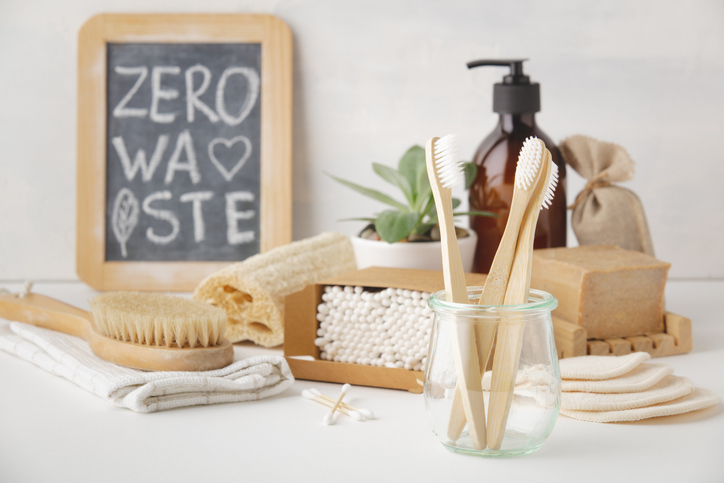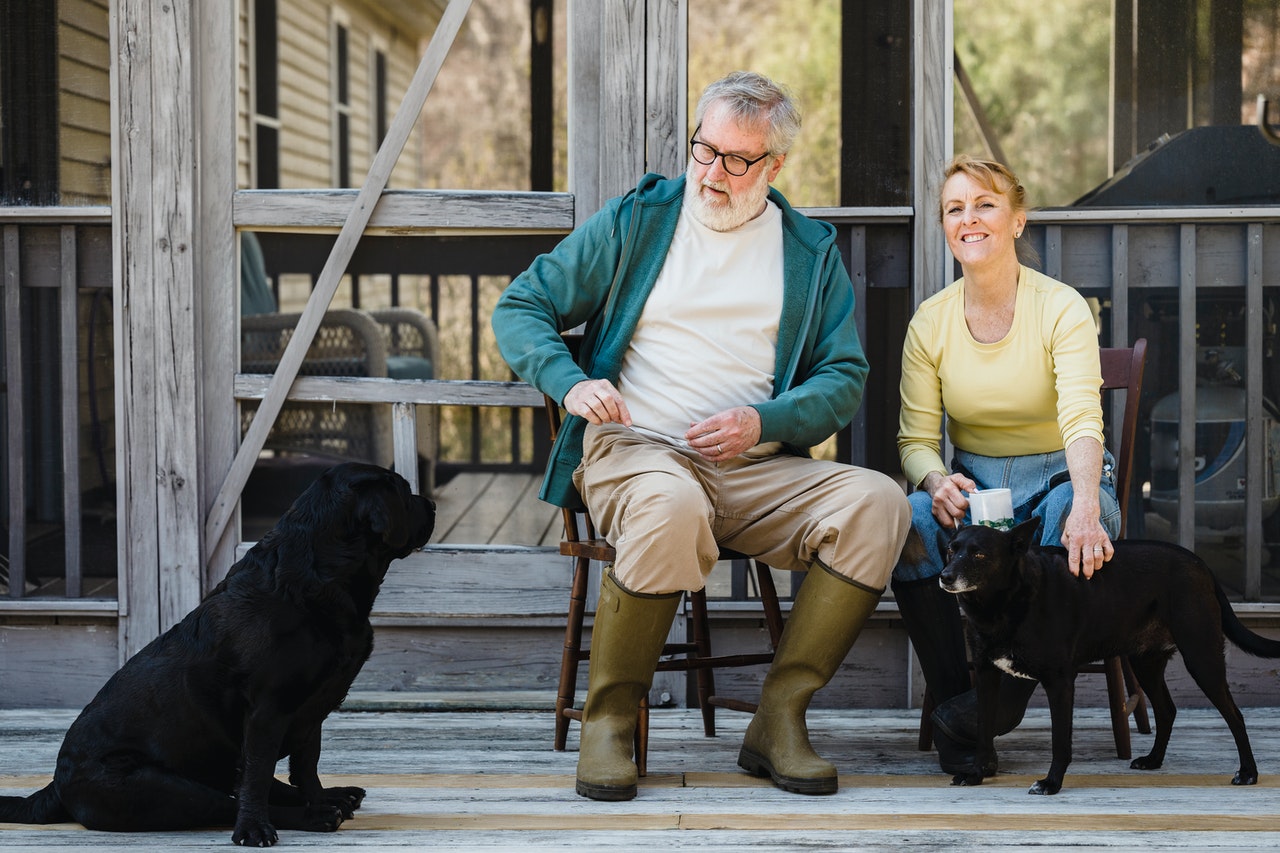Every day we see our planet crying out for help: choking from smog, drowning in plastic-filled, polluted waterways, and being buried in landfill waste from a use-it-once, throw-it-away society. One of the best things we can do is adopt an eco-friendly or zero-waste lifestyle. Being eco-friendly means trying to help, and not hurt, our environment. Zero-waste means you do nothing to harm the environment and use nothing that could pollute or end up in a landfill.
While in a perfect world we would all practice a zero-waste lifestyle, let’s start with helping you find ways to turn your own home into an eco-friendly paradise of sorts. We have some room-by-room tips that will have you reducing, recycling, and reusing like a pro.
Your “be kind to the planet” journey begins with an understanding that we all leave a carbon footprint, which is the total greenhouse gas emissions produced by a person or in this case, a building. One of the biggest factors of a home’s carbon footprint is how much electric energy it uses. This can be from appliances like refrigerators, televisions, washing machines, and air conditioners.
Reducing your home’s electricity use is a big step in reducing that carbon footprint. So, let’s look at some rooms where you can make earth-friendly changes. In the process, you may even save something green for yourself: money.
Kitchen
Let’s start with one of the busiest rooms of the house, a spot that offers lots of eco-friendly options. Your greener lifestyle can start even before you bring food into your kitchen: the choices you make while shopping.
Food packaging is a major space-filler in landfills. Packaging is designed to be appealing, but it’s wasteful and a big part of this nation’s excess trash problem. Buy eco-friendly, non-plastic packaging, or pick fresh produce without packaging at stores, vegetable stands, or organic groceries. Instead of placing produce and other groceries in plastic bags, bring your own reusable bags.
Recycle all of the packaging you can. Make a goal of putting as little at curbside as possible. If you go zero-waste, this means absolutely nothing would be waiting for the garbage truck.
Shop only for the fresh food you know you’ll eat in the next week so it doesn’t spoil and end up in the trash. This saves money while keeping food from rotting in landfills and producing harmful CO2 gas. Get creative making meals that use up the foods you have on hand. Have a “what’s left in the fridge?” meal once a week. Dice fresh produce like onions, garlic, and peppers and freeze them so you’ll always have them on hand. You can freeze many fruits and vegetables for later use.
Because plastic isn’t biodegradable, it pretty much lives forever in the landfills, so look for ways you can reduce the number of plastic items you bring into your house. For example, resist buying those single-use water bottles. Instead, install a water filter for your home and use sustainably-made reusable water bottles.
When you’re making a sandwich or snacks for lunch or a picnic, place them in reusable containers instead of one-use sandwich bags. Look for ways to reduce your dependency on plastic wraps and bags.
Even washing dirty dishes is an opportunity to go green. Try using less water, and if you’re replacing your dishwasher, research the most energy-saving models with the lowest water consumption. This will save money on your water and electric bills. Using less water also helps save the aquifer.
When cooking, choose your microwave over your conventional stove or oven and you’ll be surprised by how much energy you save.
Bedroom
Believe it or not, there are ways to make your bedroom more eco-friendly. Explore vintage shops or online selling groups for makeover accents to freshen up your decor and try your hand at DIY room updates. Look at television shows and online tutorials for inspiration and advice. Tired of the same comforter or quilt? Shop consignment stores or thrift stores for bedclothes, giving new life to items that otherwise might end up in a landfill.
If your mattress is old and you can no longer get a good night’s rest, it’s time to research mattresses made from organic, sustainable materials. Eco-friendly, easy-to-recycle bedding choices feature manufacturing processes that use less water and no harsh chemicals like microplastics. Try to stay away from polyester and nylon fabrics which aren’t kind to the environment.
Organic cotton, linen, and hemp are among the most eco-friendly fabric choices for your sheets, blankets, pillows, and clothing. Organic products are grown without environment-damaging chemicals like pesticides and fertilizers. Fabrics made from eucalyptus, birch, or beech trees are growing in popularity because of their eco-friendly growth and production processes.
Some companies now make eco-friendly bedding products by turning used water bottles into polyester, helping reduce waste while recycling. How cool is that?
Now, let’s take a look inside your clothes closet. One great way to create an eco-friendly wardrobe is to limit buying new clothes and instead find ensembles at shops that specialize in gently used items. When you clear your closet of clothes you haven’t worn in a while, consider gifting them to someone else, selling them at a consignment shop, or donating them to a thrift store.
If you own a sewing machine, consider making quilts or other new creations from unwanted clothes. For example, during the Coronavirus quarantine, many people repurposed sheets, t-shirts, and other clothing by sewing them into protective face masks.
Bathrooms
One big way to be eco-friendly in the bathroom is to take showers instead of baths. This saves both water and electricity from your water heater. You can also reuse your towels before laundering them.
Pick eco-friendly healthcare products, ones without harsh chemicals that aren’t good for either you or the environment. Look for sustainable packaging and consider re-using existing shampoo bottles and other containers. Buy large refill containers instead of smaller plastic bottles each time.
Avoid buying “scrubbing” products with microbeads, like exfoliators, body washes, and toothpaste. The plastic, non-biodegradable microbeads don’t just disappear down the drain; they end up in drinking water and also in the ocean and food chain, leaving a wake of lasting damage.
You can also find or make eco-friendly cleaning products for your bathroom and other rooms in the house. Many popular cleaning products contain harmful chemicals that aren’t friendly toward our environment and can be harmful to you. Make your own cleaning products from simple, natural ingredients like baking soda and vinegar or look for natural, green cleaning products.
Laundry Room
For many decades before dryers became popular and affordable, laundry day included a very eco-friendly drying process: a clothesline. Consider adding this to your laundry routine if possible. It’s a low-tech, high-reward way of helping the planet, and leaves your clothes smelling sunshine-fresh. Giving the dryer a rest also puts a good dent in your monthly electric bill.
If your old washing machine is beyond repair, contact a scrap collector to pick it up so parts of it can be recycled. When you’re ready to buy another washing machine, research energy-saving, water-saving models or buy one used, saving it from taking up space in the landfill.
Also, look for green laundry detergents and other products free from polluting chemicals. Those chemicals remain on your clothes which, of course, stay in contact with your skin.
Backyard
Your yard can become an oasis of green in more ways than one. Transform a boring, high-maintenance, and planet-harming lawn (which requires lots of water, fertilizers, and weed killers) into your own edible garden. There’s nothing finer than picking your own tasty, homegrown tomatoes, beans, watermelon, and more. This rewarding project saves you money at the grocery and reduces your dependency on packaging. So many ways to win! There are lots of resources online and at your library on how to start your own garden.
When it comes to fertilizing your garden, make your own free, nutrient-rich soil additive by composting natural waste products like unused fruits and veggies, peels, coffee grounds, grass clippings, and more. Add some brown stuff like leaves, twigs, and dirt, a bit of water and air, and you’ll soon have rich compost. This project not only reduces the amount of garbage leaving your property, but it cuts down on the production of methane from rotting landfill food.
If you live in an apartment or can’t set up your own composting system, you can still reduce your food trash and help the environment. Some cities have composting services that let you save your compostable items in approved containers and the company picks them up.
If you don’t have a yard for a garden, you can grow food in pots on patios, balconies, windowsills, or porch railings. Container gardening is perfect for herbs and other edibles like cherry tomatoes or peppers.
You can also make your yard more eco-friendly by planting trees that are native to your area. Not only will they provide oxygen and stabilize the soil, but in the years to come, they’ll shade your house so it stays cooler in summer. Just be sure not to plant them too close to any sun-dependent solar panels.
Looking for a patio makeover? Consider buying lounging furniture from online resale groups. This gives items a new life, keeping them out of the landfill and boosting your eco-friendly lifestyle. You can personalize these new-to-you furnishings by painting or accenting with cushions and pillows. If you choose new furniture, look for sustainably produced, natural frames like bamboo or other wood – not plastic.
Whole House
There are things you can do for the entire house that will improve its overall eco-friendly rating and make you a caretaker of this planet. One of the first ways is to turn off and unplug appliances when you’re not using them. Keeping them on standby drains electricity, and that ends up costing you money every month.
Turn off lights when you leave the room and choose longer-lasting LED bulbs. These bulbs save a tremendous amount of power and come in different shapes and brightness levels to help you match your decor needs.
In the summer, use your ceiling fans to feel cooler instead of cranking up your air conditioner. You’ll be pleasantly surprised by how much electricity this saves.
When your TV, air conditioner, laptop, or other appliance is on the blink, try fixing it instead of pitching it. Repairs are cheaper and more environmentally friendly than discarding and buying a new appliance. When you must replace an appliance, look for the most energy-efficient model, and try to donate or recycle the old one.
One of the best ways to make your entire house eco-friendly is investing in insulation. Insulating your attic and/or walls traps more heat or cool air (depending on the season) in your home, so it’s not escaping into the environment. This helps reduce your monthly energy bill, well worth the initial money spent. You can also replace older, single-paned windows with double-paned ones that help retain the inside temperature.
If you want to take your green initiatives to new heights, look up. Is your house in a sunny location? Consider having solar panels installed on the roof. These panels transform sunlight into your own renewable energy supply of electricity, reducing your monthly bill and your reliance on the electric company. You’ll get lots of eco-friendly bonus points with this decision, and some agencies even offer a rebate to go solar.
You might also consider a net-zero energy home design. Using energy-efficient and affordable construction materials, along with green energy options, can save homeowners money and help protect natural resources for decades to come.
Feel Good While Doing Good Things for the Earth
Whether you’re considering adopting a more eco-friendly lifestyle in your current home or moving and wanting to make a change to be kinder to the environment, save money, or improve your health, you’re taking part in a wonderful movement that helps ensure a brighter future for this beautiful planet.




